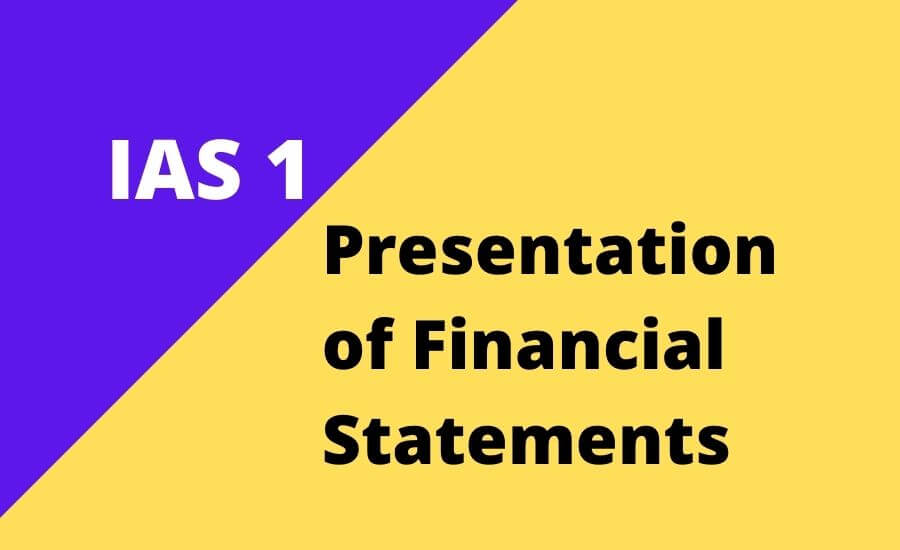IAS 1 Presentation of Financial Statements
IAS 1 is the foundation of the IAS framework and sets out the overall requirements for the presentation of financial statements. It requires companies to present their financial statements in a way that is clear, concise, relevant, reliable, and comparable.
IAS 1 specifies the overall criteria for financial statement presentation, as well as rules for their structure and minimum content requirements. It requires a business to present a comprehensive set of financial statements at least once a year, including comparative figures for the preceding year (including comparative amounts in the notes). A complete set of financial statements includes the following:
- a statement of the financial condition at the period’s end;
- a profit and loss statement for the period, as well as a statement of other comprehensive income. Other comprehensive income consists of all revenue and expense items that are not recognised in profit or loss under IFRS Standards. IAS 1 permits a company to provide either a consolidated statement of profit and loss and other comprehensive income or two distinct statements;
- a statement of the period’s developments in equity;
- a cash flow statement for the time;
- notes, which include a synopsis of major accounting policies and other explanatory material; and
- When an institution applies an accounting policy retrospectively, restates items in its financial statements retrospectively, or reclassifies items in its financial statements, it creates a statement of financial position as of the beginning of the preceding comparative period.

An organisation that prepares financial statements in accordance with IFRS Standards must include an unambiguous and unqualified declaration in the notes attesting to such conformity. An entity may not refer to financial statements as conforming with IFRS Standards unless they meet all of the Standards’ requirements. The implementation of IFRS Standards, with appropriate supplementary disclosure, is expected to result in financial statements that reflect information fairly. Additionally, IAS 1 addresses ongoing business concerns, offsetting, and changes in presentation or classification.
History of IAS 1
The International Accounting Standards Board (Board) adopted the IAS 1 Presentation of Financial Statements in April 2001, following the International Accounting Standards Committee’s initial release of the standard in September 1997. IAS 1 Presentation of Financial Statements superseded IAS 1 Disclosure of Accounting Policies (1975), IAS 5 Information to be Disclosed in Financial Statements (1977), and IAS 13 Presentation of Current Assets and Current Liabilities (1977). (approved in 1979).
The Board issued a revised IAS 1 in December 2003 as part of its initial agenda of technical projects. In September 2007, the Board issued an amended IAS 1 that included a change in the presentation of owner changes in equity and comprehensive income, as well as a change in the terminology used in the titles of financial statements. The Board amended IAS 1 in June 2011 to improve the presentation of items of other income comprehensive income.
In December 2014, IAS 1 was amended by the Disclosure Initiative (Amendments to IAS 1), which addressed concerns raised about certain existing presentation and disclosure requirements in IAS 1 and ensured that entities have the ability to exercise judgement when applying those requirements. Additionally, the amendments clarified the requirements set forth in IAS 1 paragraph 82A.
The Board issued a Definition of Material in October 2018. (Amendments to IAS 1 and IAS 8). This amendment clarified the definition of material and how it should be applied by
- incorporating guidance that had previously appeared elsewhere in IFRS Standards;
- improving the explanations accompanying the definition, and
- ensuring consistency across all IFRS Standards.
The Board published the Classification of Liabilities as Current or Non-current in January 2020. (Amendments to IAS 1). This clarified a requirement in IAS 1 for classifying a liability as non-current: an entity must have the right to defer settlement of the liability for a period of at least 12 months following the reporting period.
The Board issued the Classification of Liabilities as Current or Non-current—Deferral of Effective Date in July 2020, deferring the mandatory effective date of IAS 1 Classification of Liabilities as Current or Non-current amendments to annual reporting periods beginning on or after 1 January 2023.
Conclusion
IAS 1 is a very important standard because it sets the foundation for all other IAS standards. It is essential that companies comply with the requirements of IAS 1 in order to produce financial statements that are reliable and useful to users.
